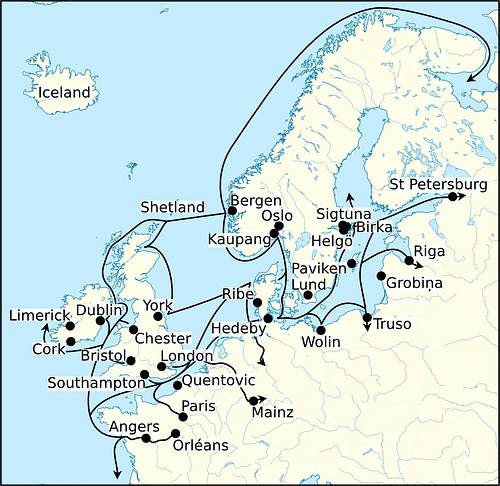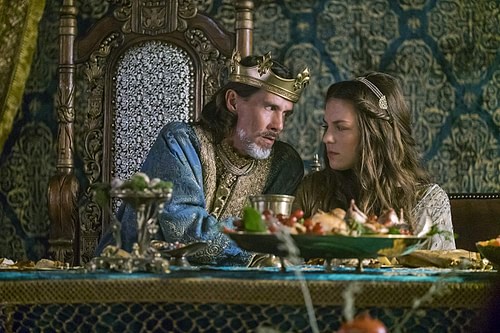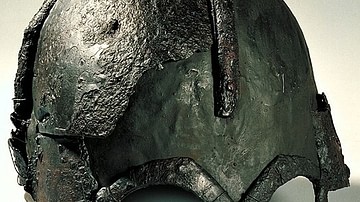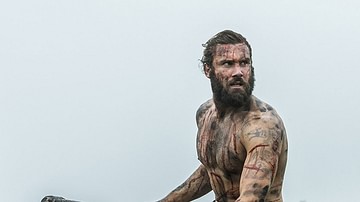Vikings (2013-present) is a historical fiction TV series created and written by English screenwriter Michael Hirst for the History Channel. Filmed in Ireland, the show draws on Scandinavian and European history and lore as it follows the life of legendary Viking chief Ragnar Lothbrok, his descendants, and the kings and cultures the Vikings influenced in the 8th and 9th centuries.
Since its premiere, questions have consistently been posed by viewers as to the historical accuracy of the show, and while there are many, some of the major differences between history and the series will be addressed below.

Warning: Spoiler Alert - if you have not seen the show yet, you may not want to read further.
Although many of the characters in Vikings are based on historical figures, and a number of events actually happened, there are significant departures throughout. In order to create a seamless narrative and engaging story arc, historical events are often telescoped, combined, compressed, or otherwise altered.
A notable example of this is how, in Season 1:2, Ragnar attacks the Lindisfarne Abbey in Northumbria (carrying off the fictional Athelstan character) and in Season 3:10 Rollo is offered land and the princess Gisla in marriage to defend West Francia from any future Viking raids. The historical attack on Lindisfarne (for which no Viking leader is named) came in 793 while the deal brokered between Charles the Simple of West Francia (r. 893-923) and Rollo the Viking chief (r. 911-927) was in 911; Ragnar and Rollo would then be over 100 years old at the time of Rollo's treaty with Charles.
The role historical regions such as Wessex or West Francia played during the Viking Age (c. 790 to c. 1100) are accurately portrayed in the series but not always the events which took place in those areas.
In most cases, the characters who appear in the show (and the places they live or travel to) did exist but not in every case. The village of Kattegat, for example, which features so prominently, never existed. The real Kattegat is actually a sea between Denmark and Sweden, and there is no record of a Scandinavian village by that name anywhere.
The character of Lagertha, although she is mentioned in the Saga of Ragnar Lothbrok, is a minor character, not the mother of Bjorn Ironside, and never was an earl; she is, however, described as an Amazon warrior very much in line with how she is portrayed in the series. The character of Floki is almost wholly fictionalized but is based on the historical figure Floki Vilgerson (9th century), who founded Iceland.
Ragnar in History vs TV Show
Ragnar Lothbrok, the main focus in seasons 1-5, may never have existed or, if he did, not as he is presented in the series. He is the hero of the Icelandic epic Saga of Ragnar Lothbrok (13th century), who slays a dragon and engages with various other mystical and fantastic elements and entities in the course of his adventures. The present scholarly consensus is that the legendary Ragnar was probably based on the Viking leader Reginherus (also given as Reginfred, 9th century), who is known only for the 845 CE Siege of Paris. There are other possible inspirations for Ragnar, however, including King Horik I of Denmark (r. 827-854), who appears as a character in the series.

Other Scandinavian poems, as well as European Latin writers, added to the basic outline of Ragnar's legend which was no doubt transmitted orally until appearing in written form in the 13th century. The character in the series shares a number of characteristics with the legendary hero but significant changes are made including:
Marriages – He was first married to Thora (who dies), according to the Saga, or to Lagertha, according to Saxo Grammaticus (13th century). After his first marriage ends, he is married to Aslaug, the mother of his famous sons, who he first knew by the name Kraka and who was disguised as a peasant maid. A number of elements from the Saga concerning Kraka/Aslaug appear in the show, especially her gift of second-sight.
Raids on Britain – In the saga, he invades Britain once, (against the advice of Aslaug who predicts his failure) and is killed by King Aella of Northumbria by being thrown into a snake pit (as is seen in the show). He never founds a settlement or has any interaction with a king of Wessex. In Season 3 of the show, Ragnar and his men are hired as mercenaries to fight the uncle and brother of Queen Kwenthryth of Mercia to restore her to power. The sequence in which the Mercian army is lined up on either side of the river, and Ragnar attacks and defeats the smaller force, is taken from accounts of the historical 845 raid on Paris in the Annals of St. Bertin (c. 840-880). Reginherus, faced with the same situation, made the same choice; afterwards he hanged 111 Frankish survivors of the battle to instill fear in those on the far side of the river.
Raids on Paris – The series combines historical events from 845 and 885-886 (the two famous raids/sieges of Paris) but with major departures from fact. In the 845 raid, Reginherus and his men found the city almost deserted, were stricken with dysentery, and would have probably left with little if the king, Charles the Bald (r. 843-877), had not offered to pay them off. More of Reginherus' men died of dysentery in the 845 siege than in combat.

In 885-886, the Vikings could not breach the walls, and the city was defended (as it is in the series) by Count Odo. The character of Gisla, daughter of King Charles in the show, was a young girl at the time of the siege of 885-886 (possibly between 5-15 years old), and did not rally the troops or do any of the other things she does in the show.
Rollo of Norway (r. 911-927) was no relation to Ragnar Lothbrok and was not present at Reginherus' 845 siege, but did participate in the 885-886 siege, did forge a contract with the king Charles the Simple, married his daughter, and founded Normandy in 911. In Season 4:8-9, the Vikings are seen raising their ships from the Seine and hauling them overland to come at Paris from another direction; this never happened in either of the Paris siege,s but Vikings did move their ships overland in the manner depicted at other times and in other locations.
The dramatic scene in Season 3:10 when Ragnar feigns his death, is carried into the cathedral, and then leaps out to kill the cleric and open the gates to his army is taken from legends concerning the Viking chief Hastein (also known as Hasting, 9th century) who raided with Bjorn Ironside. Hastein is said to have used this deceit at least twice.
Relationship with Athelstan – There is no record of a Christian monk-turned-Viking-turned-cleric who was the best friend of Ragnar Lothbrok. The most famous Athelstan of this period was the grandson of Alfred the Great (r. 871-899), Aethelstan, the first King of the English (r. 927-939).
Main Characters in History vs TV Show
Other returning characters who depart from the historical figures are Egbert of Wessex, Aethelwulf of Wessex, Alfred the Great, Kwenthryth of Mercia, Burgred of Mercia, Charles the Simple of West Francia, Odo of Paris, Aslaug, Rollo of Normandy, King Horik of Denmark, Bjorn Ironside, Sigurd Snake-in-the-Eye, Halfdane and assorted others to greater or lesser degrees. Ivar the Boneless is presented accurately although his engagements in Britain are a combination of different campaigns or battles (as in the case of the Battle of York in the show).
There is no hard evidence that Egbert (r. 802-839) was as cold-hearted and manipulative as he is presented in the show and Aethelwulf (r. 839-858) was not as dull-witted or quick-tempered. Aethelwulf, in fact, was known for his patience and consideration and was a positive role model and influence on his famous son Alfred the Great.
Alfred, of course, was not the illegitimate son of a Northumbrian princess named Judith and a cleric but the legitimate youngest child of Aethelwulf and his first wife Osburh of Wessex. Judith was actually the daughter of Charles the Bald of West Francia (r. 843-877) and was a teenager when she was betrothed to the much older Aethelwulf as his second wife after Osburh's death; he and Judith had no children.
Alfred the Great (r. 871-899) was raised by Osburh as a scholar and was possibly heading toward a career in the church since he was the youngest of five sons. If it had not been for the Viking raids on Wessex – which systematically eliminated his brothers one-by-one – the chances of Alfred succeeding to the throne would have been minimal. In the show he has only one brother, Athelred, who is unfortunately depicted as weak and wistful in comparison. Although Alfred was sickly in his youth, as a young man he was an efficient and decisive leader and able warrior. It was Alfred, not Athelred, who won the Battle of Ashdown against the Vikings in 871, and defeated them again in 878 at the Battle of Edington.
Kwenthryth of Mercia is almost wholly fictionalized but is based on three royal women from Mercia, Princess Cwenthryth (9th century), Queen Cynethryth (d. c. 800), and her daughter Eadburh (d. c. 802). The scheming and duplicitous aspects of the character are drawn largely from legends surrounding all three women.

The historical Cwenthryth was the daughter of the Mercian king Coenwulf (r. 796-821), who was involved in a dispute over land rights with Wulfred, Archbishop of Canterbury, between c. 805 and 832. Cwenthryth lost her legal battles with the Archbishop in 827 and retired to the Abbey at Winchcombe. In the 12th century, a scribe at Winchcombe, most likely irritated by the account of a woman challenging the authority of the church, wrote The Story of St. Kenelm the Little King, which casts Cwenthryth as the evil sister of the innocent young King Kenelm who plots his murder so she can take the crown. It is this version of Cwenthryth that is remembered; little is known of her actual life.
Burgred of Mercia was not Cwenthryth's brother and no relation to Cynethryth, but was king of Mercia 852-874 and husband of Aethelwulf's daughter Aethelswith (838-888). The historical Burgred died of natural causes after retiring to Rome. The scene in which Kwenthryth poisons Burgred at the celebratory feast mirrors the scribe Asser's account of Eadburh poisoning her husband, Beorhtric of Wessex (r. 786-802), in the same way. Stories concerning Cynethryth, wife of King Offa of Mercia (r. 757-796), are along these same lines, claiming she either killed or persuaded others to kill anyone she did not like.
The Frankish king Charles in the show is an amalgam of the kings Charles the Bald, Charles the Fat (r. 881-887), and Charles the Simple, none of whom were as frail or indecisive as the king in the series. Odo of Paris was the hero of the Siege of Paris, 885-886, during which he held the city against the Vikings for over a year until they were paid to leave by Charles the Fat. Odo would later become King of West Francia (888-898) after Charles the Fat was deposed; there is no evidence of the more lurid aspects of his character in the series.
The characters of the Viking leaders, such as Horik, Bjorn, Sigurd, and Halfdane, share little with their historical counterparts aside from their names. Bjorn Ironside did lead raids into the Mediterranean region and was said to be the son of Ragnar Lothbrok. He did raid in West Francia with the Viking chief Hastein and held the monasteries around Paris ransom, but there is no record of him attacking the city itself.
Horik was the king Reginherus owed allegiance to and to whom he presented the spoils of the 845 raid on Paris. Whether Horik was engaged in the kinds of intrigues seen in the show is unknown but most likely he was since it seems most leaders then, as now, engaged in numerous underhanded deals. Sigurd and Bjorn were legendary sons of Ragnar who avenged his death, along with Ivar, by killing King Aelle of Northumbria. Ivar, however, never killed Sigurd as he does in the show. Halfdane (also given as Halfdan Ragnarsson, d. 877) was one of the leaders of the Great Heathen Army of 865, along with Ivar and others, which invaded Britain.
Aslaug is far more textured in the Saga of Ragnar Lothbrok but aspects of her character appear in the TV series. As in the show, Aslaug was the daughter of Sigurd, the great Germanic hero, and Brynhild (also given as Brunhilde), the Valkyrie who both died when she was three years old. The Saga relates how she was raised in Norway by a peasant couple who call her Kraka ('crow') and conceal her noble parentage. When Ragnar meets her, in fact, he is put off by her low birth, and her true lineage is only revealed later. Aslaug's gift of second-sight enables her to accurately predict the future, including the appearance of Sigurd Snake-in-the-Eye before his birth, Ivar's boneless condition, and Ragnar's failure in his raid on Britain.
Conclusion
As one can see, there are significant departures from history throughout Vikings. The series makes no claim to be presenting accurate history, however, and its aim is to entertain, not educate. Even so, it has had the effect of engaging millions of viewers in European and Viking history and literature. Michael Hirst and the other writers on the show take full advantage of poetic and creative license in dealing with the historical events and figures, but maintain the essential truth of events during the Viking Age when Scandinavian raiders appeared on the European landscape as if from nowhere and literally changed the world forever after.






